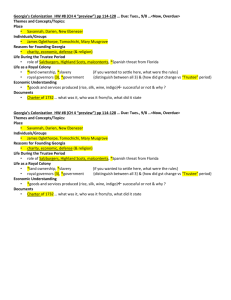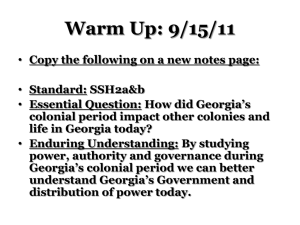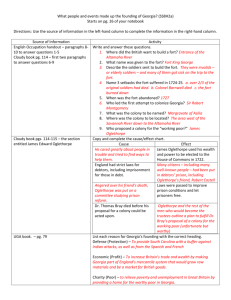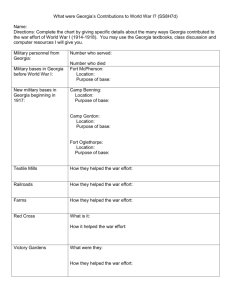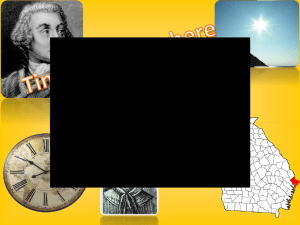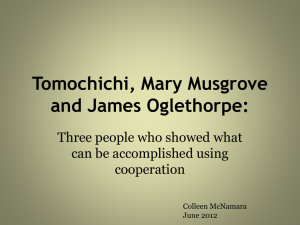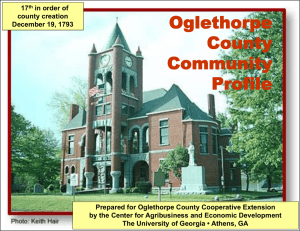The Charter of 1732
advertisement
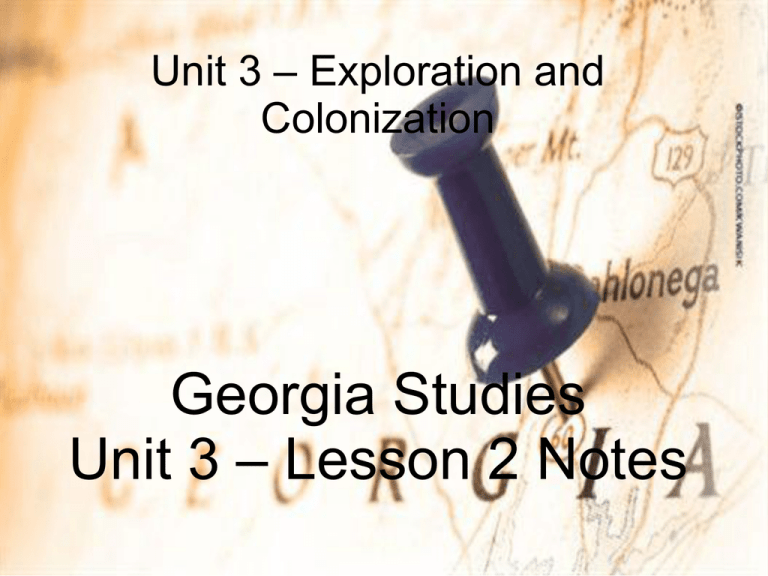
Unit 3 – Exploration and Colonization Georgia Studies Unit 3 – Lesson 2 Notes The Charter of 1732 Granted by King George II for 21 trustees to over see the establishment for 21 years All lands between the Savannah to Altamaha rivers to the Pacific Ocean Colonist were given 50 acres, agricultural supplies, and food for 1 year. If they paid their own way, they got 500 acres and could bring up to 10 indentured servants Colonist had to defend colony, grow mulberry trees, not sell land, could not pass down to female heirs, and obey all Trustees rules Trustees could not own land, hold political office, or be given money No Catholics, blacks, liquor dealers, or lawyers allowed (Included Jews, but rule was broken by Oglethorpe) Reasons for settlement #1 reason was defense. Provided a buffer between successful British South Carolina and the threat from Spanish Florida Economic (Mercantilism) wanted colonist to grow four agricultural products that could not be grown in England: wine, rice, indigo, silk (Mulberry Trees) Charity – colony for the “worthy poor.” None were sent however. Tomochichi Chief of the Yamacraw Indians (created from members of the Creek and Yamasee Indians) Believed their best opportunities would come from an alliance with the English not Spanish Gave permission for Oglethorpe to settle on Yamacraw Bluff in hopes of being allies and trading partners Developed a strong and long lasting friendship with Oglethorpe Mary Musgrove Mary Musgrove served as an interpreter for Oglethorpe and Tomochichi John and Mary Musgrove operated a trading post near the Savannah river Born to a Creek Indian mother and an English father, she understood both cultures and spoke both languages fluently Served as Oglethorpe’s personal interpreter for 10 years and moved up the ranks of colonial society Savannah 1733 - Georgia’s first city and former capital Unique as one of North America’s first planned cities Plan was to have four squares. On the north and south sides would be twenty lots. On the east and west sides would be four large lots for stores and churches. The center of each square was for gatherings Thought that Oglethorpe got the idea of the city’s layout from his friend, Robert Castell Trustee Period (1732 – 1752) 21 Trustees were for the most part religious men and social reformers Interviewed over 600 people for the 114 spots on the ship Anne. Looked for young, strong people who were not involved in liquor or interested in slavery Oglethorpe was called to England on charges of failing to capture St. Augustine when he had the opportunity. He never returned. Period ended 1 year before the Charter was set to expire, due to Oglethorpe’s permanent departure in 1743 and complaints by the Malcontents over liquor and slavery Liquor ban ended in 1742 and Slavery was allowed in 1750 Several interesting groups immigrated to GA during the Trustee Period and made major contributions Salzburgers 1733 - German speaking protestants who were forced out of present day Austria by the Catholic Church Settle in what they called “Ebenezer”, but the land was too swampy for crops and had poor water. Gained permission to relocate and named it “New Ebenezer” Highland Scots 1735 - Brought to Georgia by Oglethorpe based on their reputation as being the best soldiers in the world Brought a group of 175 Scots Given land near abandoned Fort King George near the Altamaha river, which they named Darien Soil was not good for crops, so they changed to raising cattle and harvesting timber Became very successful and credited with developing a water powered grist mill, a Sunday School, With a promise to own their land, and orphanage. Only group to they fought in the Battle of Bloody successfully produce silk Marsh and two failed campaigns to capture St. Augustine Strictly antislavery Church they built in 1763 stands today as the longest running Lutheran Church in the US Strictly antislavery, signed a petition in 1739 asking for slavery not to be introduced Malcontents Name given to those unhappy with the rules set by the Trustees Spanish Threat “War of Jenkins’ Ear” gave the English a reason to attack the Spanish Most paid their own way Oglethorpe attempted to take St. Augustine, but and were not financially failed obligated to the Trustees Complained about limits With the help of the Native Americans and on land, right to buy Highland Scots, they liquor, and the ban on successfully defeated the slavery Spanish at the “Battle of Bloody Marsh”(1742) on St. Simons Island Royal Colony 1752 - Colony overseen by the crown of England. The process took two years. Georgia had three Royal Governors during the Royal Period 1754-1756 John Reynolds: Navy Captain, introduced elected officers, allowed for assembly, and a court system, made a lot of decisions that angered the colonist, like moving the capital from the Savannah river to the Ogeechee river, which led to his recall to England 1757-1760 Henry Ellis: Was a naturalist and scientist, and for a short time a slave trader, after the debacle of Reynolds’ years, Ellis is credited with bringing self-government to Georgia, divided Georgia into eight parishes (counties), and worked to keep the Creeks neutral during war with the Cherokee, credited with increasing the population in GA, left due to health, but became a Royal Governor of Nova Scotia 1760-1776 James Wright: Born in Charles Town, educated in England, previously served as attorney general of SC, increased military around Savannah by building palisades and strengthening forts, Sunbury became GA’s official port, increased the amount of land owned and increased farm sizes, rice, indigo, and silk became profitable, first news paper (Georgia Gazette) Land Ownership Slavery Limits on the amount of land Some colonist believed in you could own were removed order to compete with other colonies like SC, slaves were Farmer could borrow money needed to purchase more land to work, from 1 to 7 million Increased from 500 in 1750 acres to 18,000 in 1775 Got more land from the Native Americans and Spanish “Undesirables” mostly of Scots-Irish decent from Virginia and SC became known as “Crackers” Slaves had no rights, treated like livestock Not allowed to marry, live where they wish, learn to read/write, were punished severally at times if rules were broken
